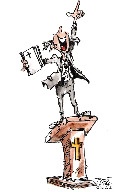Freeman, M. James Manners and Customs of the BIBLE 1.0
taken from Wordmodules.com
Preface
Though the Bible is adapted to all nations, it is in many respects an Oriental book. It represents the modes of thought and the peculiar customs of a people who, in their habits, widely differ from us. One who lived among them for many years has graphically said: “Modes, customs, usages, all that you can set down to the score of the national, the social, or the conventional, are precisely as different from yours as the east is different from the west.
They sit when you stand; they lie when you sit; they do to the head what you do to the feet; they use fire when you use water; you shave the beard, they shave the head; you move the hat, they touch the breast; you use the lips in salutation, they touch the forehead and the cheek; your house looks outwards, their house looks inwards; you go out to take a walk, they go up to enjoy the fresh air; you drain your land, they sigh for water; you bring your daughters out, they keep their wives and daughters in; your ladies go barefaced through the streets, their ladies are always covered.” (The Jordan and the Rhine, W. Graham, p. 4.)
The Oriental customs of today are, mainly, the same as those of ancient times. It is said by a recent writer that “the Classical world has passed away. We must reproduce it if we wish to see it as it was.” While this fact must be remembered in the interpretation of some New Testament passages, it is nevertheless true that many ancient customs still exist in their primitive integrity. If a knowledge of Oriental customs is essential to a right understanding of numerous Scripture passages, it is a cause of rejoicing that these customs are so stereotyped in their character that we have but to visit the Bible lands of the present day to see the modes of life of patriarchal times.

Stalker The Preacher and His Models Looks at the Preacher as a Man of God, a Patriot, a man of the Word, as a False Prophet, as a man, as a Christian, as an Apostle, and as a Thinker.
Read the Work: Stalker The Preacher and His Models.
The design of this volume is to illustrate the Bible by an explanation of the Oriental customs to which it refers. The Bible becomes more than ever a real book when we can read it understandingly. While this is eminently true of its doctrines, it is also true of its facts. A distinguished author has aptly said: “In studying the Bible the Dictionary of Things is almost as important as the Dictionary of Words.” It is a part of this “Dictionary of Things” that we propose to furnish in this book, though not in the form of a dictionary. The texts illustrated are arranged in the order in which they occur in the Bible, and are accompanied by explanations of the customs to which they allude. This method seems to be the most natural for Bible study, and is the plan followed by Burder, Rosenmüller and Roberts.
The materials for a work of this character are more abundant now than ever. Supplementing the labors of those who in former days visited Egypt and Syria, travelers have, within a few years, entered new regions and brought to light facts hitherto unknown. The explorations of such men as Botta, Layard, Loftus and Smith, and the labors of the Palestine Exploration Societies, both of England and America, have been productive of rich results, and, without doubt, results yet more valuable are to follow. The pick and the spade are to be the humble instruments of illustrating and authenticating the Word of God. Already, through their agency, important discoveries have been made. Ancient tablets covered with strange characters have been brought to light; by patient labor and wonderful ingenuity these characters have been deciphered, and made to tell the secrets which for ages they had kept concealed. The tombs of Egypt, the palaces of Assyria, and the royal records of Moab, have been compelled to speak, and now, in different languages, they bear testimony for God and his truth.
Of this varied and valuable material we have endeavored to make diligent use in the preparation of this volume. As it would encumber the work with multitudinous notes of reference to give, in every instance, the authority for the statements made, a list of the principal authors consulted is appended.
Should this volume aid the student in obtaining a better understanding of the Bible, the labor of the writer will not have been in vain.
Courtesy of BibleTruthPublishers.com. Most likely this text has not been proofread. Any suggestions for spelling or punctuation corrections would be warmly received. Please email them to: [email protected]. Manners-and-Customs-of-the-BIBLE-by-James-M-Freeman.gbk_.zip (113 downloads )
More from this Category
[introduction-background]
No Comments
Comments are closed.